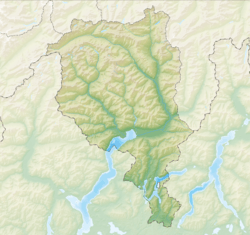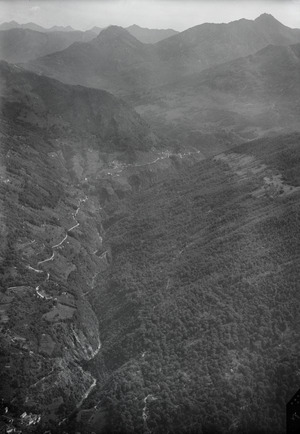Isone facts for kids
Quick facts for kids
Isone
|
||
|---|---|---|
 |
||
|
||
| Country | Switzerland | |
| Canton | Ticino | |
| District | Bellinzona | |
| Area | ||
| • Total | 12.83 km2 (4.95 sq mi) | |
| Elevation | 748 m (2,454 ft) | |
| Population
(Dec 2020 )
|
||
| • Total | 395 | |
| • Density | 30.79/km2 (79.74/sq mi) | |
| Postal code |
6810
|
|
| Surrounded by | Cadenazzo, Camorino, Capriasca, Medeglia, Pianezzo, Ponte Capriasca, Sant'Antonino | |
Isone is a small town, also called a municipality, located in the canton of Ticino in Switzerland. It's part of the Bellinzona district.
Isone is mostly known for being home to the grenadier school of the Swiss Army. Grenadiers are a special part of the infantry (foot soldiers). They have been trained in Isone since 1970. Before that, their training happened in a place called Losone.
Contents
Geography: Where is Isone Located?
Isone covers an area of about 12.82 square kilometers (about 4.95 square miles). A large part of this area, about 64.7%, is covered by forests. About 4.3% of the land is used for farming.
A smaller part, about 2.1%, has buildings and roads. There are also rivers and lakes, making up about 0.5% of the area. The rest of the land, about 10.6%, is not used for farming or building.
Isone is found in the upper part of the Vedeggio Valley. This valley is located within the Bellinzona district.
Coat of Arms: What Does Isone's Symbol Mean?
The official symbol, or blazon, of Isone's coat of arms shows Saint Lawrence. He is shown holding a grill in one hand and a palm leaf in the other.
Saint Lawrence is the patron saint of Isone. This means he is considered a special protector or guide for the town.
Demographics: Who Lives in Isone?
Isone has a population of about 364 people. A small number of these residents, about 8%, are from other countries. Over the past ten years, the population has changed a little, decreasing by about 7.7%.
Most people in Isone speak Italian, which is about 89.2% of the population. The second most common language is Serbo-Croatian, spoken by about 4.2% of residents. About 2.3% of the people speak German.
In Isone, there are slightly more men than women. About 55% of the population are male, and 45% are female.
Age Groups in Isone
The population of Isone includes people of all ages.
- About 7.4% of the population are children aged 0 to 9 years old.
- Teenagers, aged 10 to 19, make up about 6.3% of the population.
- Young adults, aged 20 to 29, are about 11.9%.
- People aged 30 to 39 make up about 13.2%.
- Those aged 40 to 49 are about 14.3%.
- People aged 50 to 59 are about 15.1%.
- Older adults, aged 60 to 69, make up about 16.7%.
- About 8.2% are between 70 and 79 years old.
- About 6.9% of the population are over 80 years old.
Homes in Isone
There are about 147 private homes in Isone. On average, about 2.4 people live in each home. Most of the buildings in Isone are single-family homes, making up about 86.6% of all inhabited buildings.
There are also some two-family buildings and a few multi-family buildings. A small number of buildings are used for both living and business purposes.
Historical Population
The number of people living in Isone has changed over many years. Here's a quick look at how the population has grown and shrunk:
| year | population |
|---|---|
| 1591 | 440 |
| 1709 | 617 |
| 1801 | 608 |
| 1850 | 789 |
| 1900 | 750 |
| 1950 | 682 |
| 1980 | 371 |
| 1990 | 383 |
| 2000 | 353 |
Economy: How Do People Work in Isone?
In Isone, the unemployment rate is quite low, around 1.12%. This means most people who want to work have jobs.
People in Isone work in different types of jobs:
- Primary sector: About 17 people work in jobs like farming or forestry. There are about 7 businesses in this area.
- Secondary sector: About 49 people work in manufacturing or construction. There are 2 businesses in this area.
- Tertiary sector: About 58 people work in services, like shops, hotels, or offices. There are 9 businesses in this area.
Many people who live in Isone travel to other towns for work. Also, many people from outside Isone come into the town to work. About 35.1% of the people who come to work in Isone are from outside Switzerland.
Most people get to work by private car (62.3%). A smaller number, about 9.4%, use public transportation.
Isone also has a few hotels, which are part of its economy.
Religion: What Beliefs Are Common in Isone?
Most people in Isone are Roman Catholic, making up about 86.1% of the population. A smaller group, about 2.5%, belong to the Swiss Reformed Church.
Some people belong to other churches not listed in the main census. A small number of people did not state their religion.
Education: Learning in Isone
Switzerland is known for having a well-educated population. In Isone, about 56.6% of adults (aged 25-64) have completed either high school or gone on to higher education, like university.
Schools in Isone
In Isone, there are about 45 students in total.
- Kindergarten: There are 6 children in kindergarten, which is not mandatory but helps prepare kids for school.
- Primary School: This program lasts for five years. There are 16 students in standard primary schools and 1 student in a special primary school.
- Lower Secondary School: After primary school, students can choose different paths. Some attend a two-year middle school followed by a two-year pre-apprenticeship program (12 students). Others attend a four-year program to get ready for higher education (3 students).
- Upper Secondary School: This level prepares students for a trade or for university. Students can attend school while doing an internship or apprenticeship. There are 3 full-time vocational students and 4 part-time vocational students.
Some students from Isone go to schools in other towns, and some students from other towns come to school in Isone.
See also
 In Spanish: Isone para niños
In Spanish: Isone para niños





